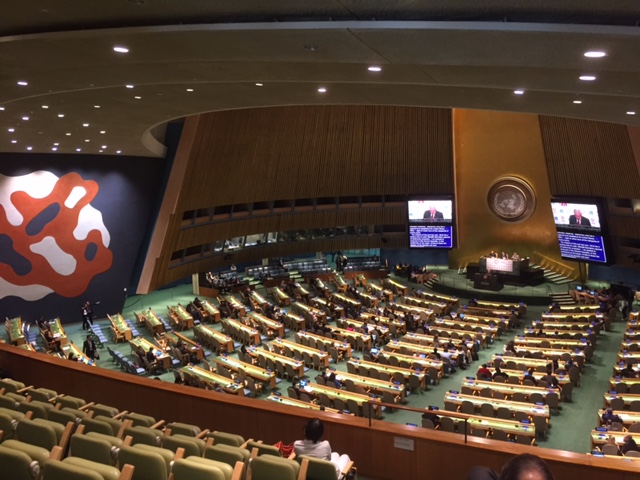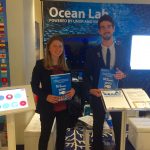By Lucy Harrington, Nereus Program intern
The third day of the UN Ocean Conference continued with plenary discussions between member state representatives on making fisheries sustainable and increasing benefits to small island developing States (SIDS) and least developed countries (LDCs).
During the side event “The Ocean Business Community: Partnering for Implementation of SDG14”, private sector panelists discussed their contributions to achieving the sustainable oceans targets by use of business collaboration and innovation.
The side event started out with a brief introduction of the importance of bridging the gap to the private sector in order to implement Sustainable Development Goal 14. The panelists emphasized the critical role that the business community plays in achieving ocean targets as well as the emerging business self-interest and desire in sustainability progress. The panelist Rich Stavis, CEO of Stavis Seafood, discussed his role in working with NGOs to create consistency in the regulations of sustainable seafood. He also recognized the challenges of fisheries that lack capacity to achieve this certification.

Fellow Gerald Singh discusses the Nereus report “Oceans and Sustainable Development Goals: Co-Benefits, Climate Change and Social Equity” with Sveriges Radio – Swedish public radio.
The panelist Donnie Brown, VP of Maritime Policy of the Cruise Line International Association, discussed his company’s contribution to reducing their global footprint. He emphasized how a commitment to the environment is their duty and that they have invested in the technology to promote energy efficiency, reduce waste, and control emissions. It was clear among all panelists that it is in their best interest to collaborate with the implementation of SDG14 and it was inspiring to hear of the various ways they have used partnerships and technological innovations to achieve the targets. It was also very exciting to hear the business community’s perspective on and dedication to ocean sustainability.
The side event “Marine Protected Areas: SDG Catalyst?” included opinions of panelists from the UNDP, the Government of Seychelles, UNDP GEF Protected Areas Project, INVEMAR, Wildlife Conservation Society, the Organization for Economic Cooperation and Development, as well as Nereus Program’s Policy Director, Dr. Yoshitaka Ota.
The focus of this side event was to examine the benefits and challenges of MPAs and their role in achieving sustainable development goals. Using examples of MPAs in New York, Seychelles, Columbia, Costa Rica, Gabon, and Madagascar, there was a clear trend in the benefits that MPAs have in increasing marine productivity within the area as well as nearby areas, known as the “spillover effect”.
During Dr. Ota’s presentation he emphasized the human dimension of MPAs and the importance of social equity. He acknowledged the outstanding benefits of MPAs to marine productivity and other SDG goals but pointed out the uncertainty of these areas with future climate scenarios as well as the need for effective and efficient management to achieve long-term MPA goals. He stressed the need for a “code of conduct” for marine conservation and the inclusion of communities in management. During the discussion, a major point that was brought up was the enforcement of MPAs after the “glitzy” implementation and how important it is to design MPAs with a strong framework specific to the local community’s needs. Overall, the answer to the question “Are Marine Protected Areas a SDG catalyst?” was YES.

The UN General Assembly during the UN Ocean Conference.
The side event “Coastal blue carbon ecosystems- supporting food security, sustainable oceans and climate action” was organized by the government of Australia in cooperation with the International Oceanographic Commission of UNESCO, the International Union for Conservation of Nature, Conservation International, and the Nature Conservancy. The event began with a quick introduction to blue carbon and its role in securing social, economic, and environmental outcomes as well as its importance in addressing climate change.
Blue carbon is the carbon that is sequestered, stored, or released in the coastal ecosystems of mangroves, tidal marshes, and seagrass beds. These ecosystems are said to store two to four times more carbon than terrestrial ecosystems! However, when these ecosystems are lost or destroyed the carbon that they contain is released and is a major source of emissions globally. The goal of the side event was to increase awareness of these ecosystems and encourage actions of conservation. Panelists from the Government of Fiji, Australia, and the UAE showcased their country’s strategies in pursuing coastal conservation. Panelists of NGOs such as Conservation International, WWF, CSIRO, and IUCN discussed the working groups aimed at assisting interested parties in pursuing coastal carbon restoration and conservation. The panelists emphasized the benefits that blue carbon has on the various other sustainable development goals, especially Goal 13: Climate Action.

Lucy Harrington
Lucy is an undergraduate intern with the Nereus Program. She has worked with Dr. Ota and Dr. Teh examining the various aspects of fishermen job quality on a global fisheries scale. She will be returning to classes in the fall to pursue a bachelors degree in Marine Biology at Northeastern University in Boston, MA to graduate spring 2019. She is excited to be attending the Oceans Conference and very grateful for the opportunity!







